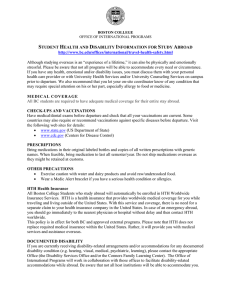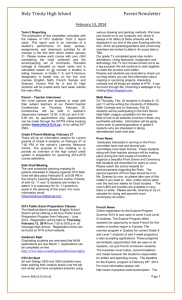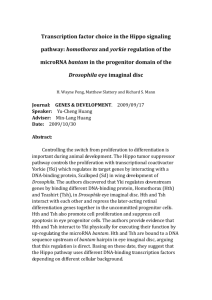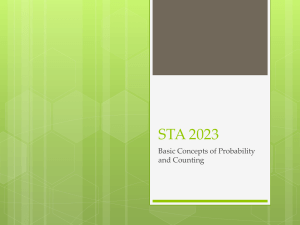High Tech High San Diego Unified School District Practices Worthy of Attention
advertisement
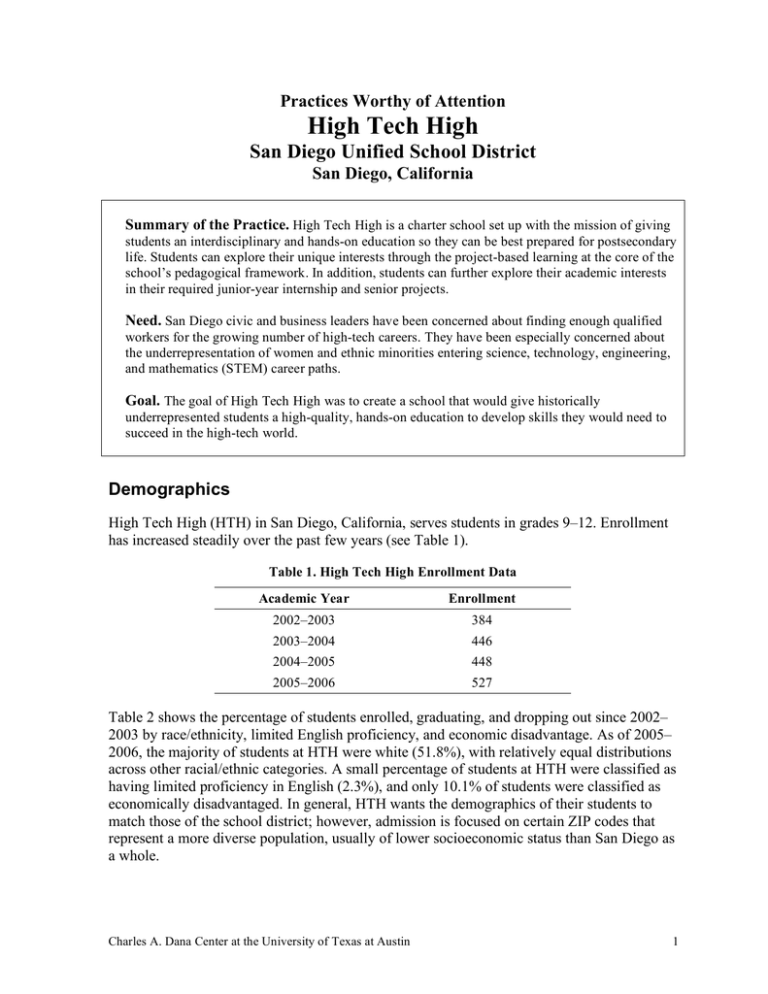
Practices Worthy of Attention High Tech High San Diego Unified School District San Diego, California Summary of the Practice. High Tech High is a charter school set up with the mission of giving students an interdisciplinary and hands-on education so they can be best prepared for postsecondary life. Students can explore their unique interests through the project-based learning at the core of the school’s pedagogical framework. In addition, students can further explore their academic interests in their required junior-year internship and senior projects. Need. San Diego civic and business leaders have been concerned about finding enough qualified workers for the growing number of high-tech careers. They have been especially concerned about the underrepresentation of women and ethnic minorities entering science, technology, engineering, and mathematics (STEM) career paths. Goal. The goal of High Tech High was to create a school that would give historically underrepresented students a high-quality, hands-on education to develop skills they would need to succeed in the high-tech world. Demographics High Tech High (HTH) in San Diego, California, serves students in grades 9–12. Enrollment has increased steadily over the past few years (see Table 1). Table 1. High Tech High Enrollment Data Academic Year Enrollment 2002–2003 384 2003–2004 446 2004–2005 448 2005–2006 527 Table 2 shows the percentage of students enrolled, graduating, and dropping out since 2002– 2003 by race/ethnicity, limited English proficiency, and economic disadvantage. As of 2005– 2006, the majority of students at HTH were white (51.8%), with relatively equal distributions across other racial/ethnic categories. A small percentage of students at HTH were classified as having limited proficiency in English (2.3%), and only 10.1% of students were classified as economically disadvantaged. In general, HTH wants the demographics of their students to match those of the school district; however, admission is focused on certain ZIP codes that represent a more diverse population, usually of lower socioeconomic status than San Diego as a whole. Charles A. Dana Center at the University of Texas at Austin 1 Practices Worthy of Attention High Tech High Table 2. High Tech High Enrollment, Graduation, and Dropout Rates Demographics All Students Asian American/ Pacific Islander/ Filipino Black Hispanic White Limited English Proficient Economically Disadvantaged Academic Year Percentage Enrolled Percentage Graduating Percentage Dropping Out 2002–2003 100 100 0 2003–2004 100 100 0 2004–2005 100 100 0 2005–2006 100 100 * 2002–2003 15.6 100 0 2003–2004 18.6 100 0 2004–2005 16.0 100 0 2005–2006 17.4 100 * 2002–2003 15.6 100 0 2003–2004 15.2 100 0 2004–2005 13.2 100 0 2005–2006 12.1 100 * 2002–2003 17.2 100 0 2003–2004 16.6 100 0 2004–2005 15.4 100 0 2005–2006 18.6 100 * 2002–2003 50.5 100 1 2003–2004 48.7 100 1 2004–2005 54.7 100 0 2005–2006 51.8 100 * 2002–2003 2.3 100 * 2003–2004 2.7 100 * 2004–2005 3.1 100 * 2005–2006 2.3 100 * 2002–2003 12.3 100 * 2003–2004 11.1 100 * 2004–2005 12.9 100 * 2005–2006 10.1 100 * Note: The asterisk (*) notes that data were not available. Charles A. Dana Center at the University of Texas at Austin 2 Practices Worthy of Attention High Tech High Description of the Practice High Tech High was an idea conceived in the late 1990s by civic and business leaders in San Diego, who were concerned about finding enough qualified workers for the growing number of high-tech careers. These leaders were also concerned about the underrepresentation of women and ethnic minorities entering science, technology, engineering, and mathematics (STEM) career paths. The group decided to start a charter school where historically underrepresented students would be passionate about learning and receive an education that would develop the STEM-related skills they would need to succeed in the high-tech world. In 2000, HTH began as a single charter school focusing on solutions for dealing with student disengagement and low academic achievement: personalized, project-based learning environments where all students were expected to graduate well prepared for college. The mission of HTH is to “develop and support innovative public schools where all students develop the academic, workplace, and citizenship skills for postsecondary success.” Their goals include serving students who represent the socioeconomic diversity of the local community; integrating technical and academic education with hands-on, real-life experiences that prepare students for postsecondary education; increasing the success rate of educationally disadvantaged students in mathematics and engineering in high school and beyond; and graduating students who will be “thoughtful and engaged citizens” who readily participate in their community. HTH believes in the interaction of vision and practice through its three design principles: personalization, adult world connection, and common intellectual mission. These three principles connect to the purpose of schools: to prepare students for success in the adult arena. The three principles were pulled from the work of the New Urban High School Project that analyzed and assisted six urban high schools using school-to-work strategies, such as internships (see Big Picture Co., 1998). The design principles are part of the school culture: personalization of students’ learning and academic growth through advisory, project-based learning that prepares students for their postsecondary lives, and common planning time for teachers built into the school day. Personalization Each HTH student is assigned a staff advisor. The advisory program was designed to support students in their academic preparation for college. The advisor assigned to each student acts as a liaison to the family as well, so parents are aware of their child’s growth and challenges at HTH. Advisors work closely with students to help them plan for their future and navigate the college admissions process. At each grade level, different aspects of college preparation and the application process are discussed. This way, students are thinking about being college-bound as soon as they enter HTH, and their academic experiences in high school serve as preparation for their college lives. The college advising department also works with parents for each grade level, so that parents are also receiving similar information about what is expected of their children in this college-bound environment. The college advising department provides financial aid and scholarship information and helps arrange for students to meet with college admissions counselors who visit HTH. Charles A. Dana Center at the University of Texas at Austin 3 Practices Worthy of Attention High Tech High Adult World Connection The adult world connection design principle is addressed through the teaching and learning framework, which includes project-based learning and internships, usually in STEM areas. HTH describes itself as an “inquiry-based liberal arts school where the lines between ‘technical’ and ‘academic’ are deliberately blurred” (High Tech High, n.d.). HTH offers hands-on experiences in mathematics and science through project-based learning (part of students’ daily lives) and internships. The curriculum is framed around the inquiry-based model, where students are actively involved in asking questions and problem solving. Realworld applications are a regular component of the curriculum, which is usually interdisciplinary, so students can see different content within a real-life context. Teachers work together on content across academic courses to develop a coherent curriculum that reflects the interdisciplinary nature of the real world. Teachers develop curriculum units that pose certain questions or themes for students, rather than developing six separate courses that do not interact or integrate ideas clearly. Project-based learning is the key focus for students’ learning at HTH. After mathematics teachers provide the lesson and tasks for students to engage in, students break into their smaller learning groups to work on projects that apply the mathematics concept to a larger hands-on activity. Since the classrooms are grouped by grade level and students come in with differing levels of mathematical proficiency, classes are taught in ways that cover the span of several mathematics courses; for example, Algebra I, Geometry, and Calculus are taught in the same class where the teacher focuses on a mathematics strand and differentiates the difficulty in the project activity for students. Students work within and across groups to gain advice and input for their projects, and the teachers check in with each group to monitor the projects and provide support and guidance as needed. In addition, HTH believes in making all student work public, so there is outside accountability that puts pressure on students to do well, since all their peers will be seeing their work. Students’ work is posted over the entire campus of HTH and is regularly rotated due to the large number of products that result from each project. Beginning in their junior year, students work as interns on Tuesday and Thursday afternoons for at least one semester at local businesses, schools, nonprofit organizations, or professional associations. They work on a specific project that is overseen by a mentor. This mentor understands and supports HTH’s design principles, and works individually with the student to cultivate a productive learning experience. In addition to working on their project at their internships, students are expected to write in their journals about their internships and regularly communicate with their employer, mentor, and school internship coordinator about the internship. The internship is required for graduation, as it provides students with work skills and applies their project-based learning in a real-world business. Common Intellectual Mission The common intellectual mission is to expect the same high-quality standards for both teachers and students. When a mathematics teacher is accepted as a new faculty member, the teacher is required to participate in HTH’s state-approved teaching certification program if they do not already have a teaching credential. However, all new HTH faculty members need Charles A. Dana Center at the University of Texas at Austin 4 Practices Worthy of Attention High Tech High training and certification in deeply understanding the content matter, applying that content to real-world experiences, and integrating learning across disciplines. Teachers are inducted into HTH’s intellectual mission and vision through HTH’s teacher intern program (TIP). In TIP, teachers begin to engage in professional learning communities that model HTH’s learning goals, integrating technical and academic education and creating a community of responsible teachers. Teachers receive on-the-job training in TIP, which includes 120 hours of pre-service training as well as 600 hours of training and practice over the two-year program. A variety of professional development workshops are held in two- to three-day meetings throughout the course of the academic year, focusing on different aspects of teaching and learning that are important to HTH’s design principles. Teacher interns learn early on about project-based learning and HTH design principles, since they work in the classroom full-time while in TIP. Both new and continuing teachers spend three days mid-year talking about differentiated instruction and other forms of assessment at HTH, which include observing classrooms. These meetings provide a common platform for discussing what is working and what needs to be improved. In addition, HTH teachers are involved in daily common planning periods. Four mornings a week before school, High Tech High teachers meet. Teachers use this planning time to devise and analyze outcomes of integrated projects, common rubrics for assessment, and common rituals by which all students demonstrate their learning and progress toward graduation. All students in their first two years of high school take the same curriculum during the school day. However, students can explore their own individual interests in their small groups and projects, so learning can always be personalized, even with the standardized program. Students are assigned teams for the entire year in both ninth and tenth grade, and attend the entire school day with the same group of students for the entire academic year. In their junior and senior years, students are offered more opportunities to expand their areas of interest, which is when the curriculum can be differentiated. For instance, although there is no honors track at HTH, students can work for an honors-weighted credit, depending on the depth of their project-based learning experiences and goals. Advanced Placement (AP) courses are not a part of the curriculum at HTH, given the different learning model associated with these courses. Since HTH emphasizes project-based work over content coverage, AP courses will likely never be part of the school’s curricular program. Expectations are the same for all students: to attend school every day and to be engaged in learning. Even though admission to HTH is lottery-based (because they have more applicants than open spaces), students are still considered self-selected, since they had to apply to HTH for admission. This means students and/or parents understand the mission of HTH and the different educational experience they will have upon entering this school. School and classroom culture is an important aspect of HTH’s program. HTH has created a safe environment for learning, where there is a sense of helpfulness among student peers and across disciplines. This type of interaction is encouraged and modeled continuously in the ninth and tenth grades, and students learn to interact in this manner as an acceptable form of school culture. Charles A. Dana Center at the University of Texas at Austin 5 Practices Worthy of Attention High Tech High Developing a common mission was not easy for HTH. After the first year, 50% of teachers left HTH, either willingly or unwillingly. It became obvious whether teachers were a good match for the intensity and the applied and interdisciplinary nature of the academic program. Some teachers left because the school was not what they thought it would be (e.g., no tracking or AP/Honors courses). Some teachers felt the curriculum was not rigorous enough. Some teachers left because they did not buy into the school culture of student personalization. Since the vision of HTH is to benefit students, providing them with the best resources and teachers necessary to help them become academically successful, HTH leadership wants to ensure that the teachers who stay are the best fit for the vision of the school. Results Over 50% of HTH graduates are first-generation college-bound students, and 100% of HTH’s graduates have been admitted to college. About 80% have been admitted to four-year universities, including Howard University, Johns Hopkins University, Massachusetts Institute of Technology, New York University, Northwestern University, Stanford University, University of Southern California, University of San Diego, and University of California at Berkeley. The Academic Performance Index (API) is a numeric score ranging from 200 to 1,000 that reflects the performance of a school or district on California’s standardized testing and reporting results. In Table 3, San Diego Unified School District API results are listed at the district level, including elementary and middle school APIs, whereas the California APIs are specifically for high school (it appears that the APIs tend to be lower for high school than for elementary and middle schools). Based on the API, High Tech High students continue to outperform their local district and state counterparts. In general, API scores are increasing, except for one year at HTH when scores dropped below 800. HTH has an API of about 100 scale points higher than San Diego for most years, and higher than California for the two years of available data. These APIs rank HTH in the top 10% of public high schools in California. Table 3. Academic Performance Index (API) for High Tech High Compared to the State and Local District Year Tested High Tech High San Diego Unified School District California 2003 802 697 * 2004 831 710 * 2005 792 728 671 2006 829 735 Note: The asterisk (*) notes that data were not available. 680 In addition, HTH’s black and Hispanic students outperform their district and state counterparts. Black and Hispanic students at HTH have higher test scores and a higher percentage of enrollment in higher-level courses, such as chemistry, physics, and advanced Charles A. Dana Center at the University of Texas at Austin 6 Practices Worthy of Attention High Tech High mathematics. In fact, 100% of HTH’s black and Hispanic students are enrolled in these higher-level courses and 100% are admitted to college. Conclusions High Tech High is in its seventh academic year and has franchised several High Tech High– brand schools in the San Diego area and beyond. The reasons for expanding High Tech High are at least threefold. Smaller schools with appropriate student support allow for personalization of education to each student, which encourages students to take more interest in their own learning. Providing a certification program onsite for new teachers allows for immediate training on the principles and frameworks for teaching and learning at High Tech High; the common vision and intellectual mission are readily stated and reinforced in the professional development trainings, for certification and beyond, as well as daily in the common planning time for all High Tech High staff. The adult world connection, with realworld applications built into the curriculum and internships required and carefully managed, allows students to see the interdisciplinary nature of education. High Tech High results show that underrepresented students are engaged in higher-level curricula than their peers and are achieving higher as well, as seen in test scores and graduation and college admission rates. It appears that HTH’s attention to the three design principles has provided a possible solution for providing successful STEM preparation for historically underrepresented students. References Big Picture Co. (1998). The new urban high school: A practitioner’s guide. Providence, RI: Author. High Tech High. (n.d.). Frequently asked questions: General school philosophy. Retrieved December 17, 2007, from http://www.hightechhigh.org/faq.php. Charles A. Dana Center at the University of Texas at Austin 7 Practices Worthy of Attention High Tech High About Practices Worthy of Attention: Local Innovations in Strengthening Secondary Mathematics Practices Worthy of Attention is a joint initiative of Achieve, Inc. (www.achieve.org), and the Charles A. Dana Center at The University of Texas at Austin (www.utdanacenter.org). The initiative is led by Pamela L. Paek, a research associate at the Dana Center, who, in 2006, examined 22 program, school, and district practices that showed promise—based on early evidence and observation—of strengthening secondary mathematics teaching and learning. Our goal was to document practitioners’ descriptions of what is really happening in the field to strengthen secondary mathematics education around the country. Thus, while the practice highlighted may be common, the specific structures and strategies used to implement the practice are worthy of attention. These initial investigations set out to mark these practices for future rigorous scientific inquiry by Dana Center and other researchers. Ultimately, we hope to create a community of inquiry made up of university researchers working with administrators and teachers from featured schools and districts to more rigorously research how effectively these practices improve secondary mathematics learning for all students. Reports and practice profiles. An executive summary details the methods for this initiative and analyzes themes. Two cross-case analyses discuss specific strategies for raising student achievement and building teacher capacity. Brief profiles describe each practice. All of these publications are available on our website at www.utdanacenter.org. Data. In all cases, data about the practice were provided by the program, school, or district studied as part of a description of their practice. We did not independently analyze data gathered through a consistent assessment tool, and we did not evaluate their uses of data for measuring effectiveness. Thus, the data in the practice profiles are intended not to prove the practice’s effectiveness from a research perspective, but to paint a detailed picture of the practice and what data were used by the program, school, or district to gauge how well it was working. Theoretical frameworks. In some cases, district staff mentioned specific literature on theory or practice that they used when they developed the practice we highlight. In those cases, we cite that literature in our discussion of the practice. How to cite this profile Paek, P. L. (2008, January). High Tech High. Case study from Practices worthy of attention: Local innovations in strengthening secondary mathematics. Austin, TX: Charles A. Dana Center at The University of Texas at Austin. Charles A. Dana Center at the University of Texas at Austin 8
